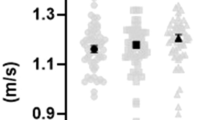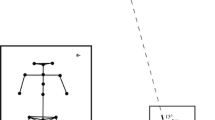Abstract
The notion that locomotion concerns with moving from state to state (Higgins et al., Advances in experimental social psychology, Academic Press, New York, NY, 2003; Kruglanski et al., J Pers Soc Psychol 79:793–815, 2000) will instill a positive disposition toward multi-tasking was explored in three studies. Study 1 demonstrated the existence of the hypothesized link between locomotion and multi-tasking in a sample of university students. Study 2 showed that a person-situation fit in organizations based on this preference affects employees’ sense of well being. Finally, Study 3 conceptually replicated the results of Study 2 and demonstrated that the fit effects on well-being from the relation between locomotion and multi-tasking hold when both these variables are manipulated experimentally. These results support the basic idea that individuals with strong locomotion concerns benefit from activities more when they are performed simultaneously rather than sequentially.


Similar content being viewed by others
References
Aaker, J. L., & Lee, A. Y. (2006). Understanding regulatory fit. Journal of Marketing Research, 43, 15–19.
Aiken, L. S., & West, S. G. (1991). Multiple regression: Testing and interpreting interactions. Thousand Oaks, CA: Sage Publications.
Avnet, T., & Higgins, E. T. (2003). Locomotion, assessment, and regulatory fit: Value transfer from ‘‘how’’ to ‘‘what’’. Journal of Experimental Social Psychology, 39, 525–530.
Bluedorn, A. C. (2002). The human organization of time: Temporal realities and experience. Stanford, CA: Stanford University Press.
Bluedorn, A. C., & Denhardt, R. B. (1988). Time and organizations. Journal of Management, 14, 299–320.
Bluedorn, A. C., Kalliath, T. J., Strube, M. J., & Martin, G. D. (1999). Polychronicity and the Inventory of Polychronic Values (IPV): The development of an instrument to measure a fundamental dimension of organizational culture. Journal of Managerial Psychology, 14, 205–230.
Bluedorn, A. C., Kaufman, C. J., & Lane, P. M. (1992). How many things do you like to do at once?: An introduction to monochronic and polychronic time. The Academy of Management Executive, 14, 17–26.
Brayfield, A. H., & Rothe, H. F. (1951). An index of job satisfaction. Journal of Applied Psychology, 35, 307–311.
Carver, C. S., & Scheier, M. F. (1981). Attention and self-regulation: A control-theory approach to human behavior. New York, NY: Springer-Verlag.
Cohen, S., Kamarck, T., & Mermelstein, R. (1983). A global measure of perceived stress. Journal of Health and Social Behavior, 24, 385–396.
Conte, J. M., & Jacobs, R. R. (2003). Validity evidence linking polychronicity and Big Five personality dimensions to absence, lateness, and supervisory ratings of performance. Human Performance, 16, 107–129.
Conte, J. M., Rizzuto, T. E., & Steiner, D. D. (1999). A construct-oriented analysis of individual-level polychronicity. Journal of Managerial Psychology, 14, 269–287.
Feldman, L. P., & Hornik, J. (1981). The use of time: An integrated conceptual model. Journal of Consumer Research, 7, 407–417.
Fitzsimons, G. M., Friesen, J., Orehek, E., & Kruglanski, A. W. (2009). Progress-induced goal-shifting. In J. P. Forgas, R. F. Baumeister, & D. M. Tice (Eds.), Self-regulation: Cognitive, affective, and motivational processes (pp. 181–194). New York, NY: Psychology Press.
Förster, J., Friedman, R., & Liberman, N. (2004). Temporal construal effects on abstract and concrete thinking: Consequences for insight and creative cognition. Journal of Personality and Social Psychology, 87, 177–189.
Forster, J., Higgins, E. T., & Idson, L. C. (1998). Approach and avoidance strength during goal attainment: Regulatory focus and the “goal looms larger” effect. Journal of Personality and Social Psychology, 75, 1115–1131.
Hall, E. T. (1959). The silent language. New York, NY: Anchor Books.
Hall, E. T. (1983). The dance of life. Garden City, NY: Anchor Press.
Hecht, T. D., & Allen, N. J. (2005). Exploring links between polychronicity and well-being from the perspective of person-job fit: Does it matter if you prefer to do only one thing at a time? Organizational Behavior and Human Decision Processes, 98, 155–178.
Higgins, E. T. (2000). Making a good decision: Value from ‘‘fit’’. American Psychologist, 55, 1217–1230.
Higgins, E. T. (2005). Value from regulatory fit. Current Directions in Psychological Science, 14, 208–213.
Higgins, E. T. (2009). Regulatory fit in the goal-pursuit process. In G. B. Moskowitz & H. Grant (Eds.), The Psychology of Goals. New York: Guilford Press.
Higgins, E. T. (2011). Beyond pleasure and pain: How motivation works. New York: Oxford University Press.
Higgins, E. T., Kruglanski, A. W., & Pierro, A. (2003). Regulatory mode: Locomotion and assessment as distinct orientations. In M. P. Zanna (Ed.), Advances in experimental social psychology (Vol. 35, pp. 293–344). New York, NY: Academic Press.
Kashdan, T. B., Rose, P., & Fincham, F. D. (2004). Curiosity and exploration: Facilitating positive subjective experiences and personal growth opportunities. Journal of Personality Assessment, 82, 291–305.
Kaufman, C. F., Lane, P. M., & Lindquist, J. D. (1991). Exploring more than 24 hours a day: A preliminary investigation of polychronic time use. Journal of Consumer Research, 18, 392–401.
Kaufman-Scarborough, C., & Lindquist, J. D. (1999). Time management and polychronicity: Comparisons, contrasts, and insights for the workplace. Journal of Managerial Psychology, 14, 288–312.
Kruglanski, A. W., Pierro, A., Higgins, E. T., & Capozza, D. (2007). “On the Move” or “Staying Put”: Locomotion, need for closure, and reactions to organizational change. Journal of Applied Social Psychology, 37, 1305–1340.
Kruglanski, A. W., Thompson, E. P., Higgins, E. T., Atash, M. N., Pierro, A., Shah, J. Y., et al. (2000). To ‘‘do the right thing’’ or to ‘‘just do it’’: Locomotion and assessment as distinct self-regulatory imperatives. Journal of Personality and Social Psychology, 79, 793–815.
Kuhl, J. (1994). Action versus state orientation: Psychometric properties of the Action Control Scale (acs-90). In J. Kuhl & J. Beckmann (Eds.), Volition and personality: Action versus state orientation (pp. 9–46). Toronto: Hogrefe & Huber.
Lewin, K. (1951). Field theory in social science. New York: Harper.
Mannetti, L., Giacomantonio, M., Pierro, A. (2011). Locomoting toward well-being or getting entangled in a material world: Regulatory modes and affective well-being. Manuscript under review.
McClelland, G. H., & Judd, C. M. (1993). Statistical difficulties of detecting interactions and moderator effects. Psychological Bulletin, 114, 376–390.
Mobley, W. (1977). Intermediate linkages in the relationship between job satisfaction and employee turnover. Journal of Applied Psychology, 62, 237–240.
Ophir, E., Nass, C. I., & Wagner, A. D. (2009). Cognitive control in media multitaskers. Proceedings of the National Academy of Sciences, USA, 106(37), 15583–15587.
Pierro, A., Kruglanski, A. W., & Higgins, T. E. (2006). Regulatory mode and the joys of doing: Effects of “Locomotion” and “Assessment” on intrinsic task-motivation. European Journal of Personality, 20, 355–375.
Raggi, V. L., & Chronis, A. M. (2006). Interventions to address the academic impairment of children and adolescents with ADHD. Clinical Child and Family Psychological Review, 9, 85–111.
Schell, K. L., & Conte, J. M. (2008). Associations among polychronicity, goal orientation, and error orientation. Personality and Individual Differences, 44, 288–298.
Scholer, A. A., & Higgins, E.T. Commitment to change from locomotion motivation during deliberation. Motivation and Emotion (in press).
Shah, J. Y., Friedman, R. S., & Kruglanski, A. W. (2002). Forgetting all else: On the antecedents and consequences of goal shielding. Journal of Personality and Social Psychology, 83, 1261–1280.
Silvia, P. J. (2008). Appraisal components and emotion traits: Examining the appraisal basis of trait curiosity. Cognition and Emotion, 22, 94–113.
Slocombe, T. E., & Bluedorn, A. C. (1999). Organizational behavior implications of the congruence between preferred polychronicity and experienced work-unit polychronicity. Journal of Organizational Behavior, 20, 75–99.
Terracciano, A., McCrae, R. R., & Costa, P. T. (2003). Factorial and construct validity of the Italian Positive and Negative Affect Schedule (PANAS). European Journal of Psychological Assessment, 19, 131–141.
Toulouse, E., & Pieron, H. (1986). Toulouse-Pieron. Prueba perceptiva y de atencion. Madrid: TEA.
Watson, D., Clark, L. A., & Tellegen, A. (1988). Development and validation of brief measures of positive and negative affect: The PANAS scales. Journal of Personality and Social Psychology, 54, 1063–1070.
Author information
Authors and Affiliations
Corresponding author
Appendices
Appendix 1: Locomotion Scale
-
1. I don’t mind doing things even if they involve extra effort. [0.45]
-
2. I am a “workaholic”. [0.53]
-
3. I feel excited just before I am about to reach a goal. [0.48]
-
4. I enjoy actively doing things, more than just watching and observing. [0.69]
-
5. I am a “doer”. [0.66]
-
6. When I finish one project, I often wait awhile before getting started on a new one. (reversed) [0.28]
-
7. When I decide to do something, I can’t wait to get started. [0.55]
-
8. By the time I accomplish a task, I already have the next one in mind. [0.53]
-
9. I am a “low energy” person. (reverse-scored) [0.63]
-
10. Most of the time my thoughts are occupied with the task I wish to accomplish. [0.50]
-
11. When I get started on something, I usually persevere until I finish it. [0.59]
-
12. I am a “go-getter. [0.69]
-
Note: Component loadings are reported in brackets.
Appendix 2: Multi-tasking preference scale. Study 1
-
1. I like to juggle several activities at the same time. [0.71]
-
2. I would rather complete an entire project everyday than complete parts of several projects (reversed). [0.57]
-
3. I believe people should try to do many things at once. [0.68]
-
4. I prefer to do one thing at a time (reversed). [0.78]
-
5. I believe people do their best work when they have many tasks to complete. [0.55]
-
6. I believe it is best to complete one task before starting another. (reversed) [0.75]
-
7. I would rather complete parts of several projects everyday than complete an entire project. [0.65]
-
8. I seldom like to work on more than a single task at the same time (reversed). [0.78]
-
9. When I have several things to do, I prefer to spend a little bit of time on each—moving back and forth from one thing to the other. [0.66]
-
Note: Component loadings are reported in brackets.
Appendix 3: Multi-tasking demands items. Study 2
-
1. My job demands that I juggle several activities at the same time. [0.77]
-
2. On my job, I am required to complete entire projects everyday, rather than completing parts of several projects (reversed). [0.57]
-
3. This job requires people to do many things at once. [0.76]
-
4. When doing this job, work must be done one thing at a time (reversed). [0.68]
-
5. It is typical of my job to have many tasks to complete. [0.63]
-
6. My job requires me to complete one task before starting another (reversed). [0.68]
-
7. On my job, I am required to complete parts of several projects everyday, rather than completing an entire project. [0.62]
-
8. In my job I am seldom required to work on more than a single task at the same time (reversed). [0.74]
-
9. My job often requires that I spend a little bit of time on several tasks—moving back and forth from one thing to the other. [0.59]
-
Note: Component loadings are reported in brackets.
Rights and permissions
About this article
Cite this article
Pierro, A., Giacomantonio, M., Pica, G. et al. Locomotion and the preference for multi-tasking: Implications for well-being. Motiv Emot 37, 213–223 (2013). https://doi.org/10.1007/s11031-012-9300-y
Published:
Issue Date:
DOI: https://doi.org/10.1007/s11031-012-9300-y




